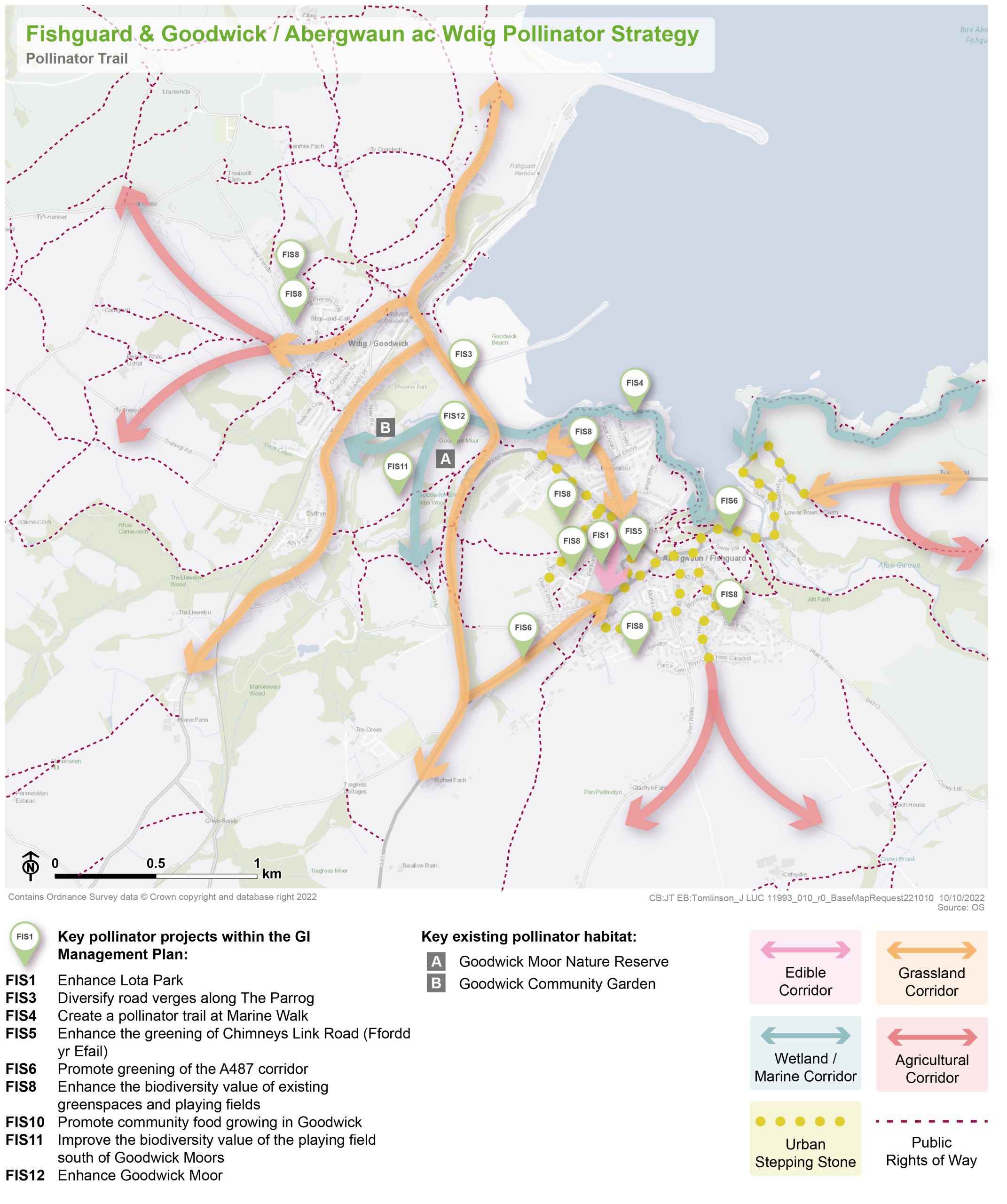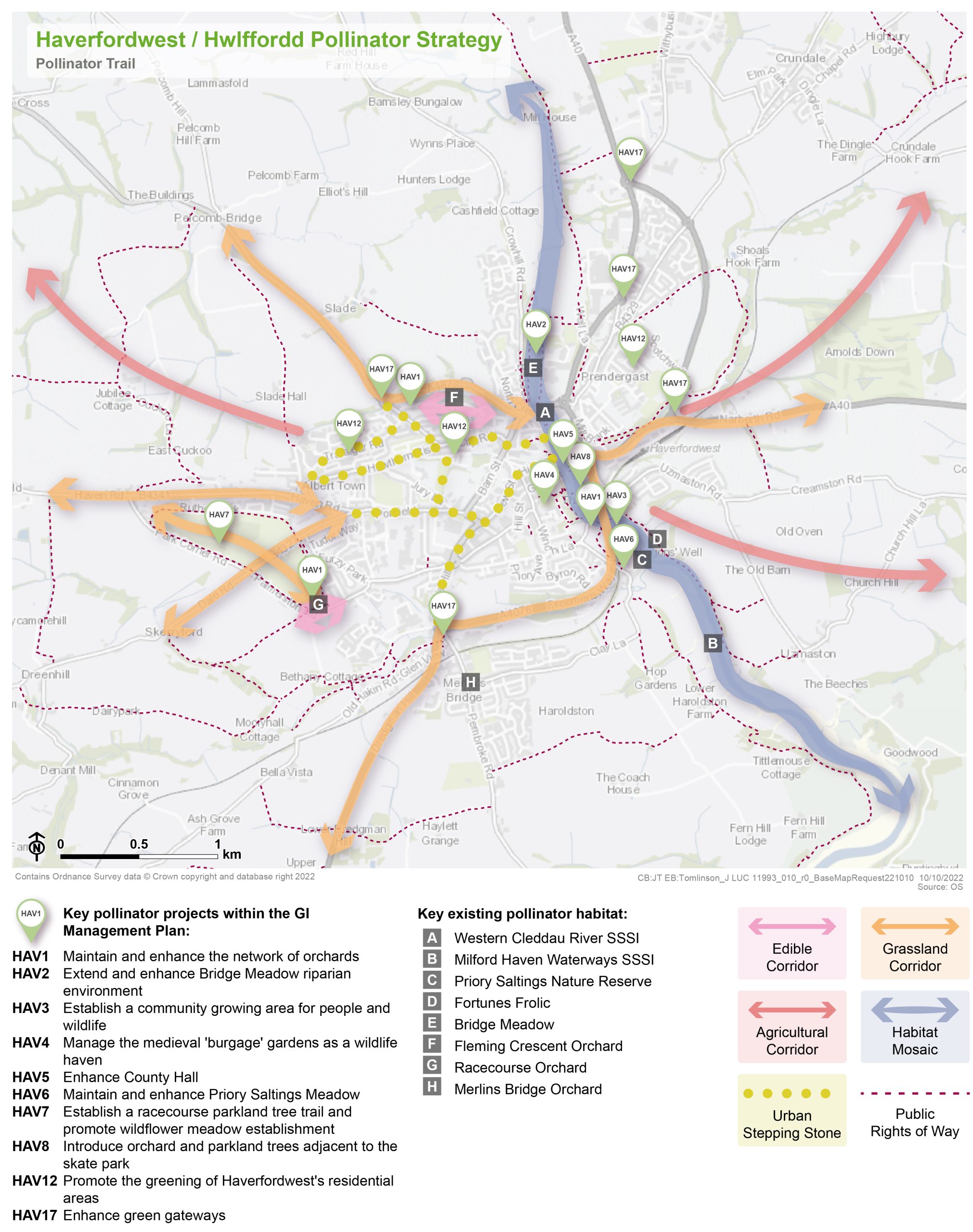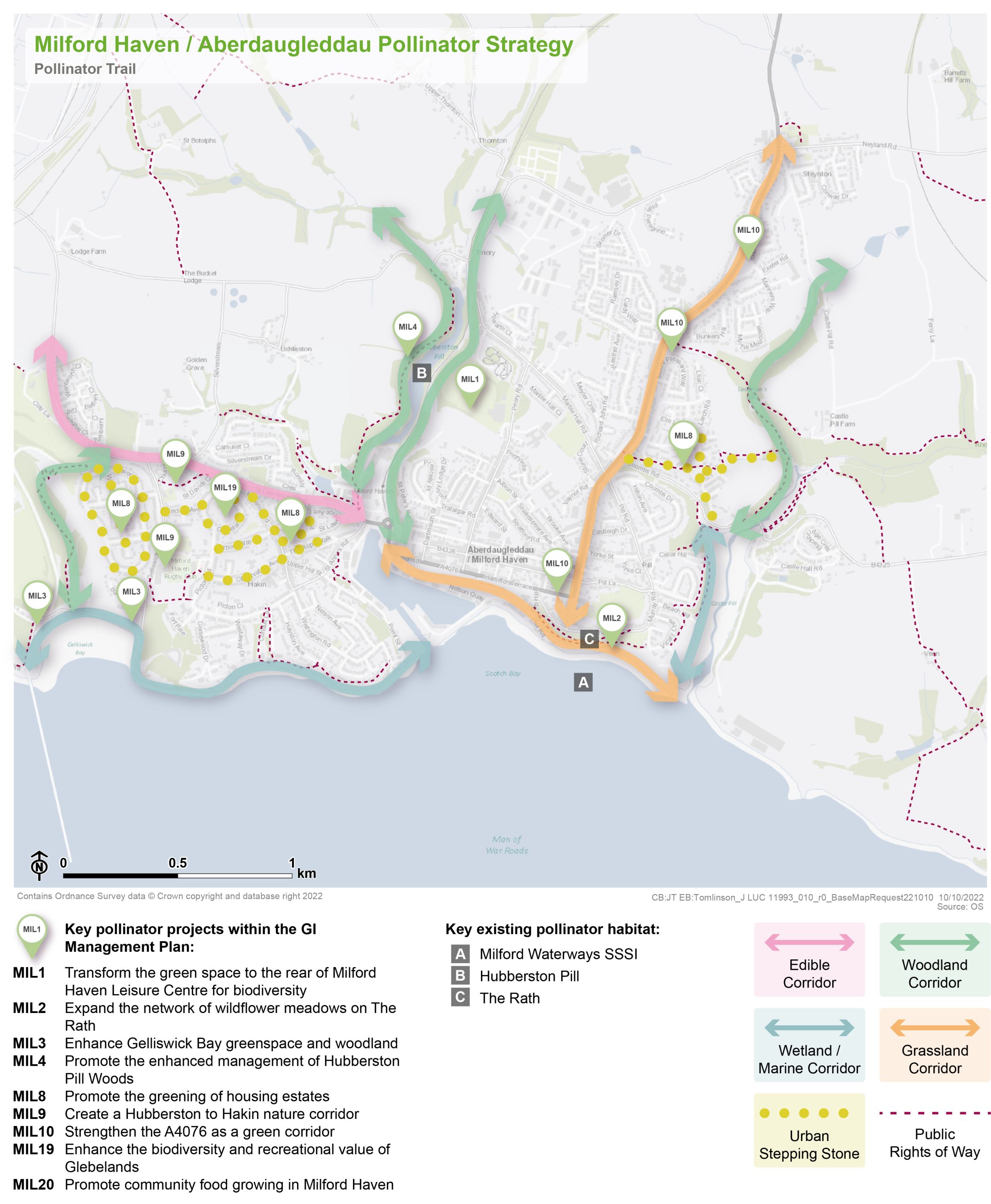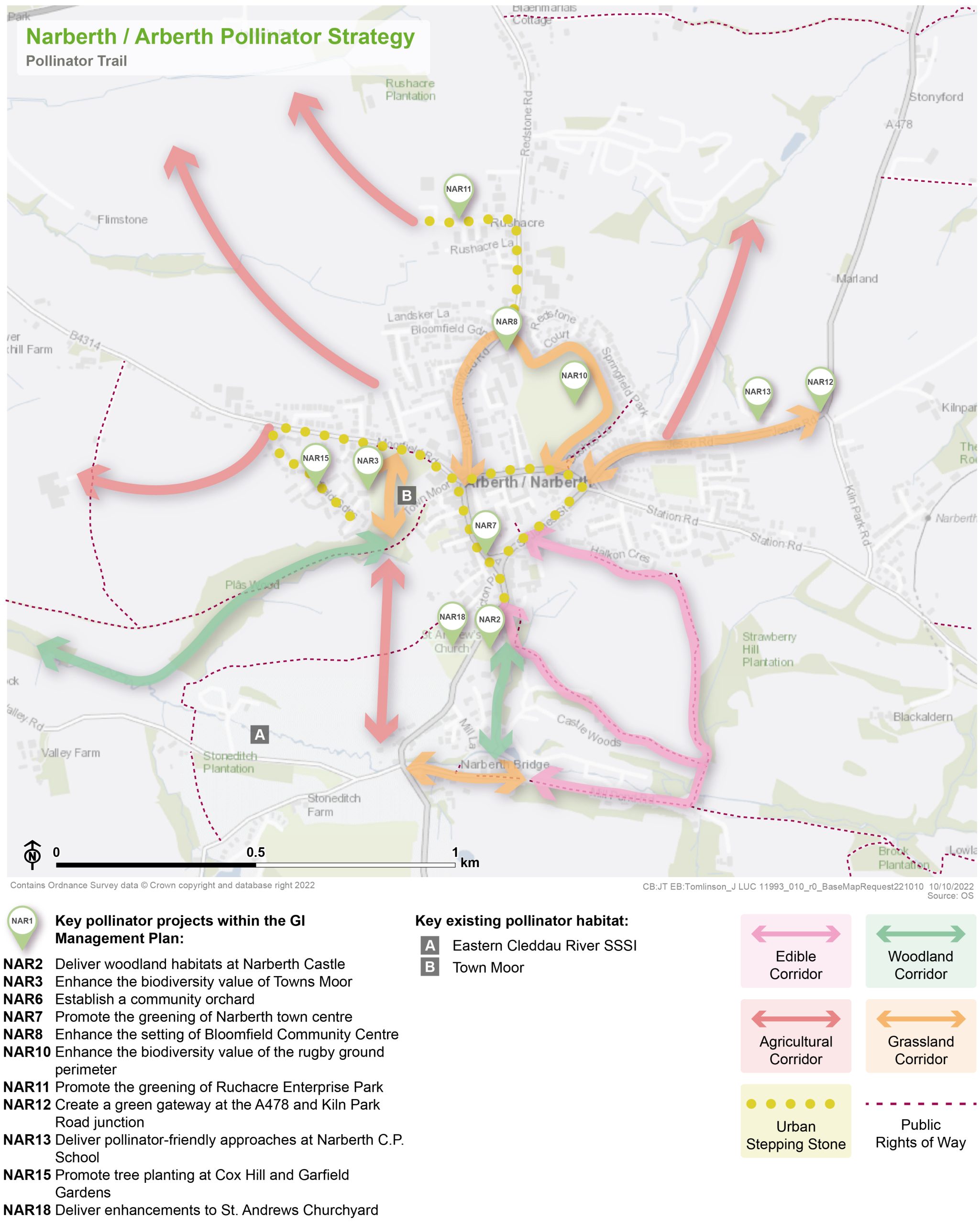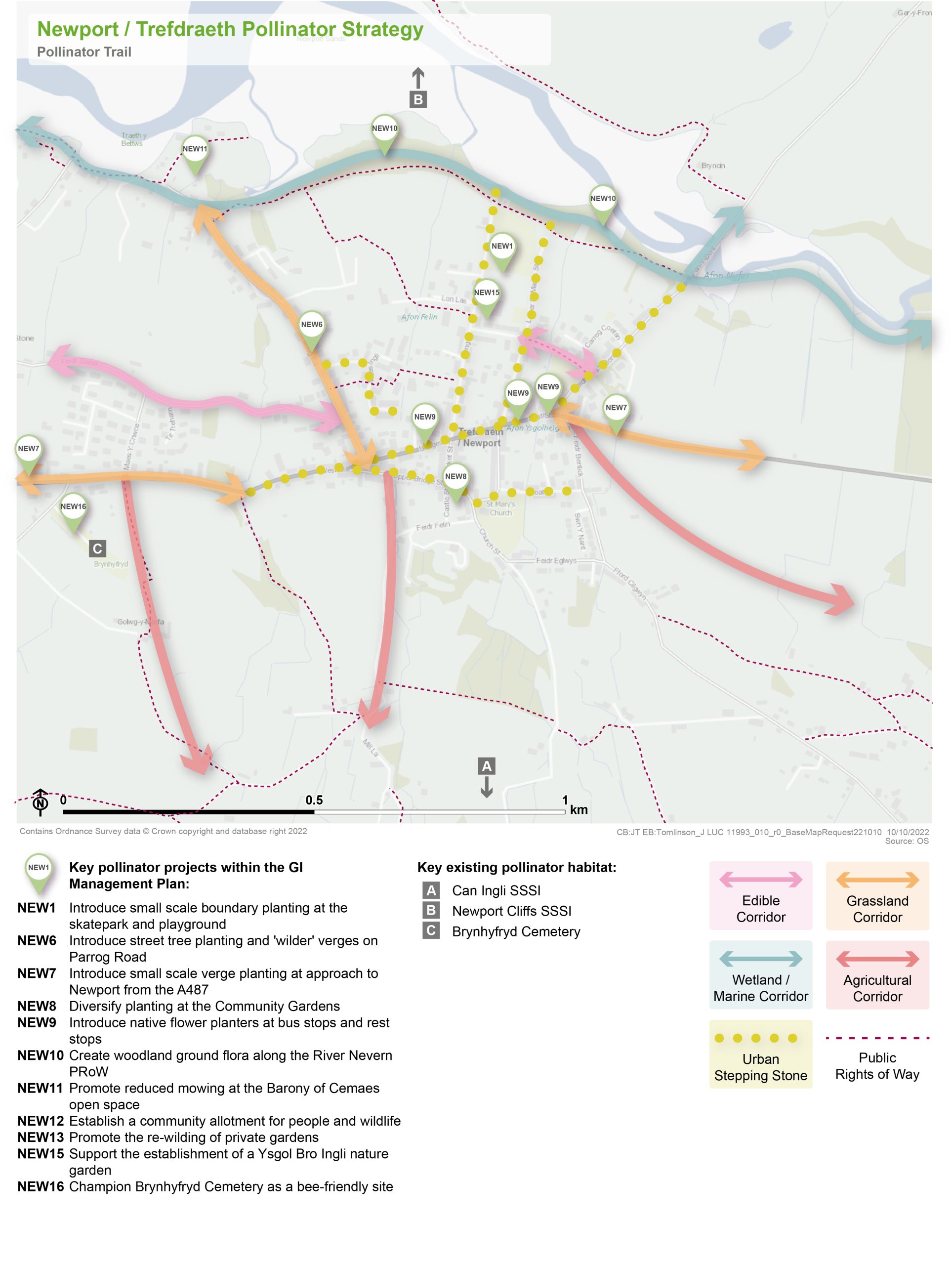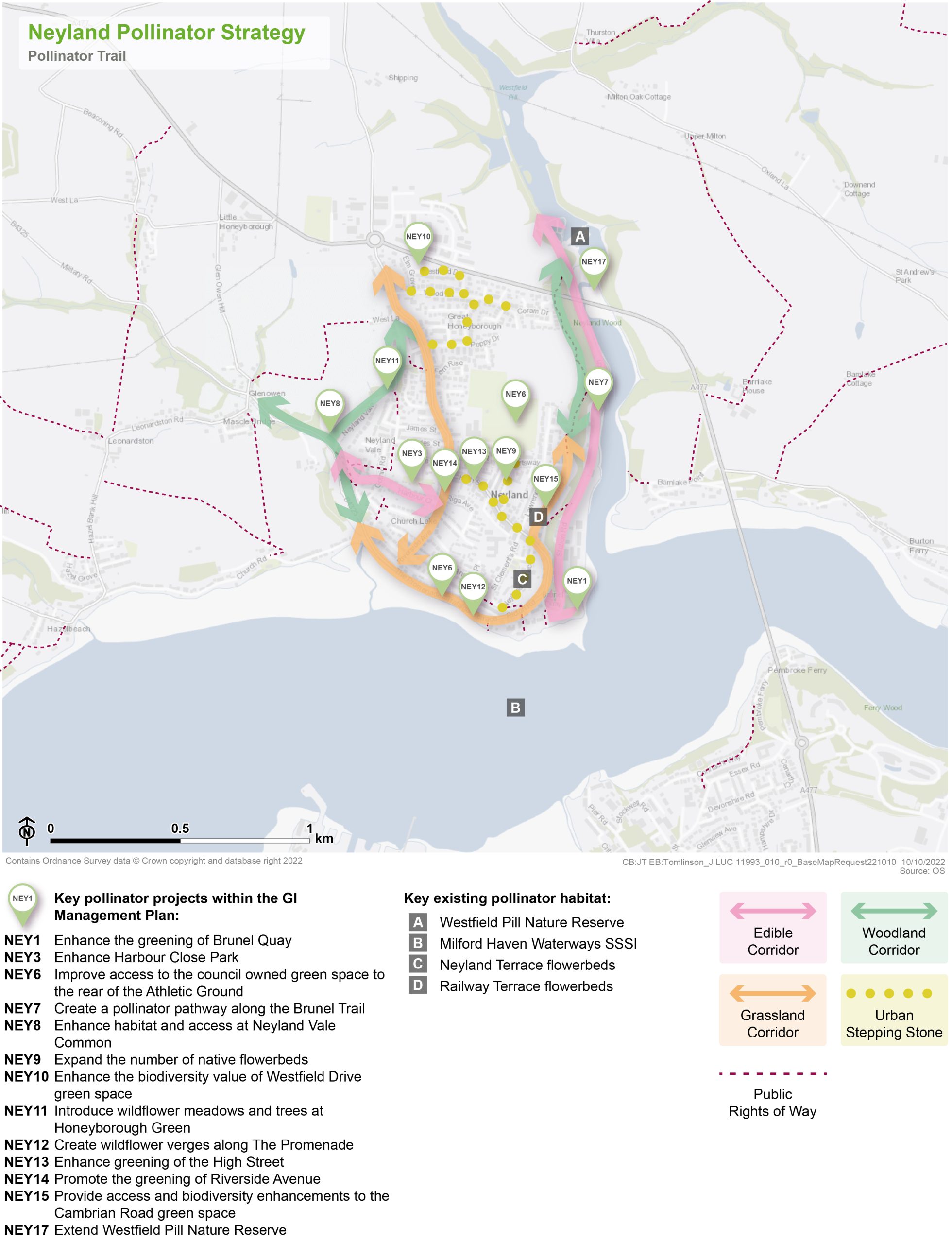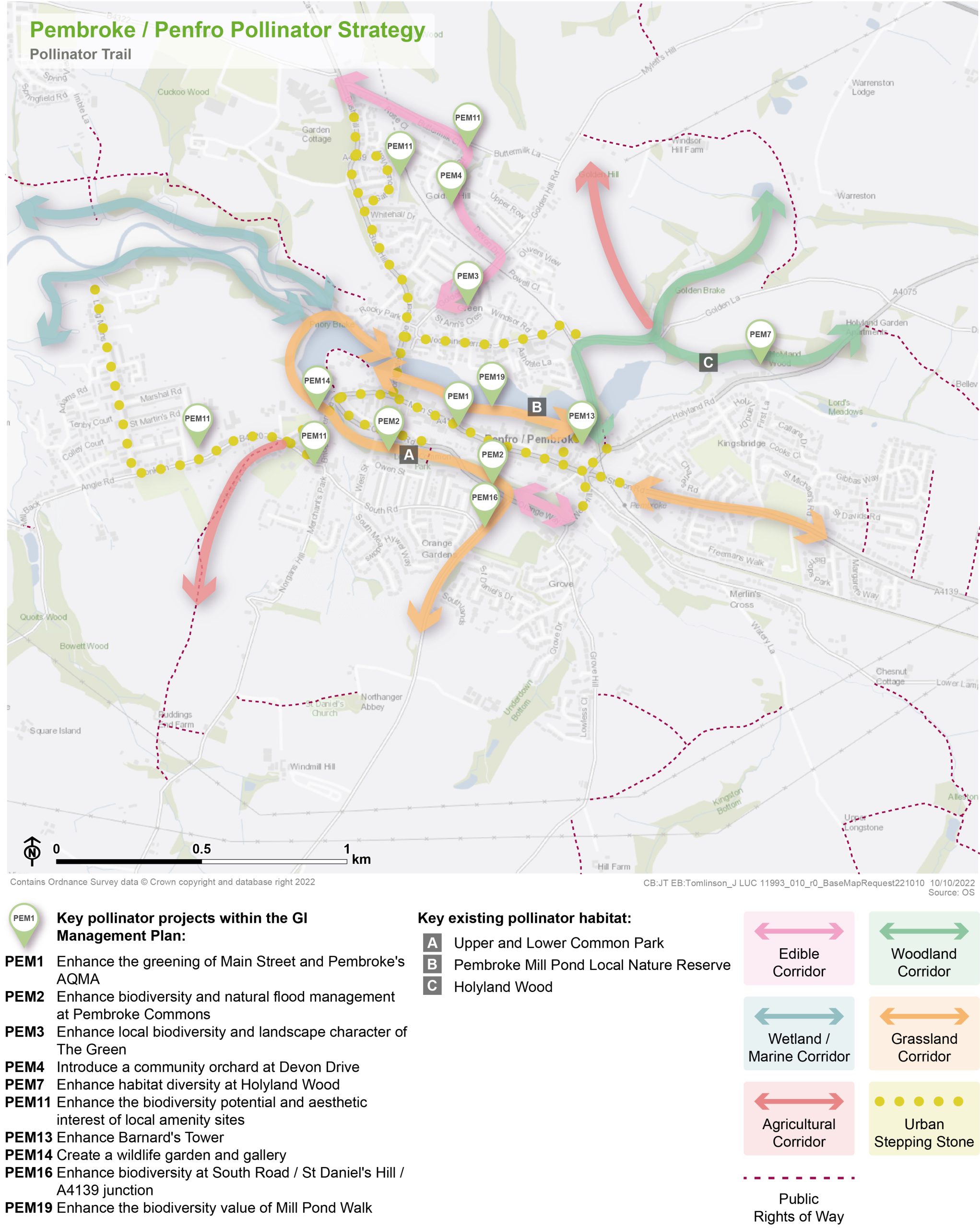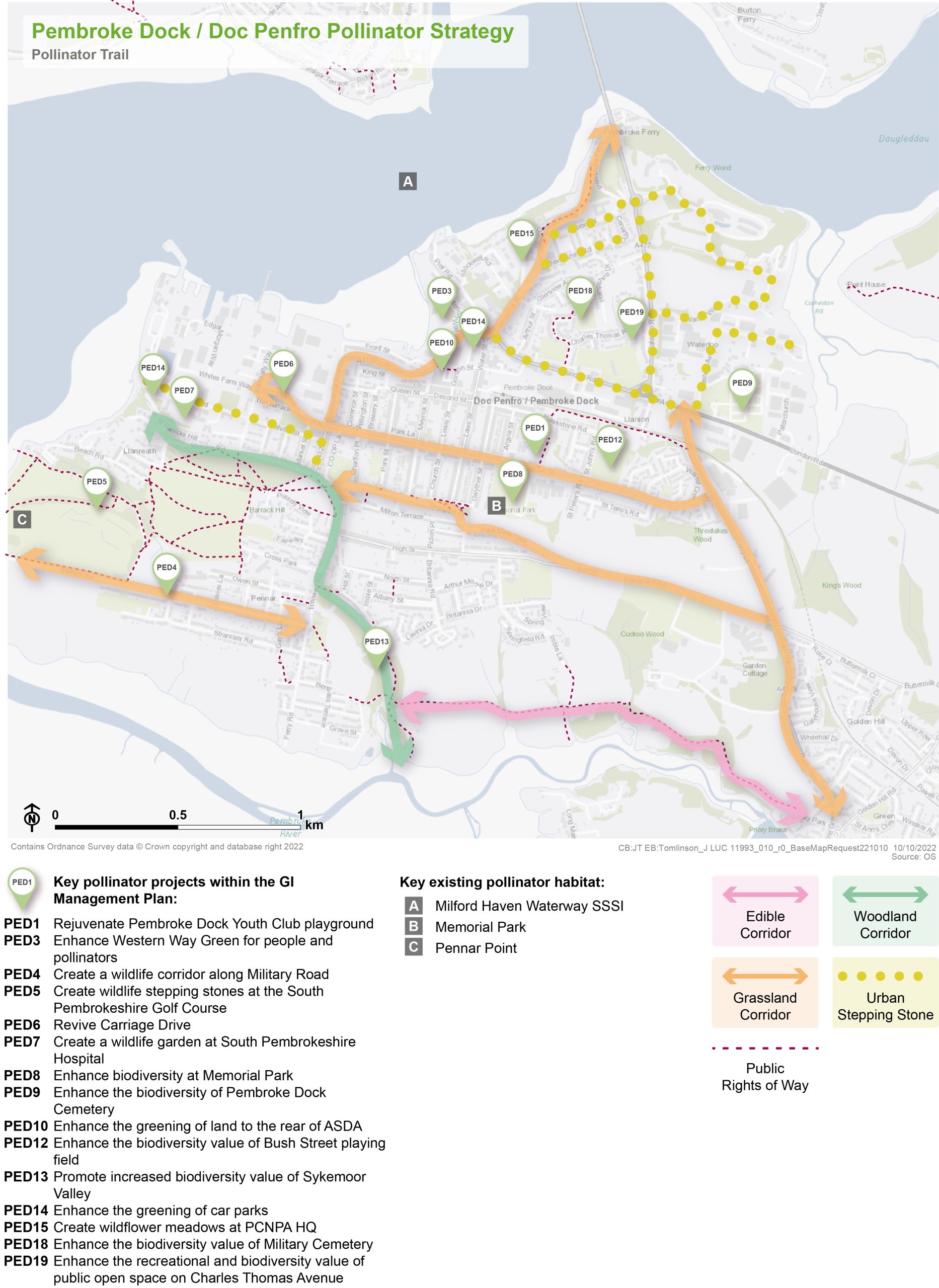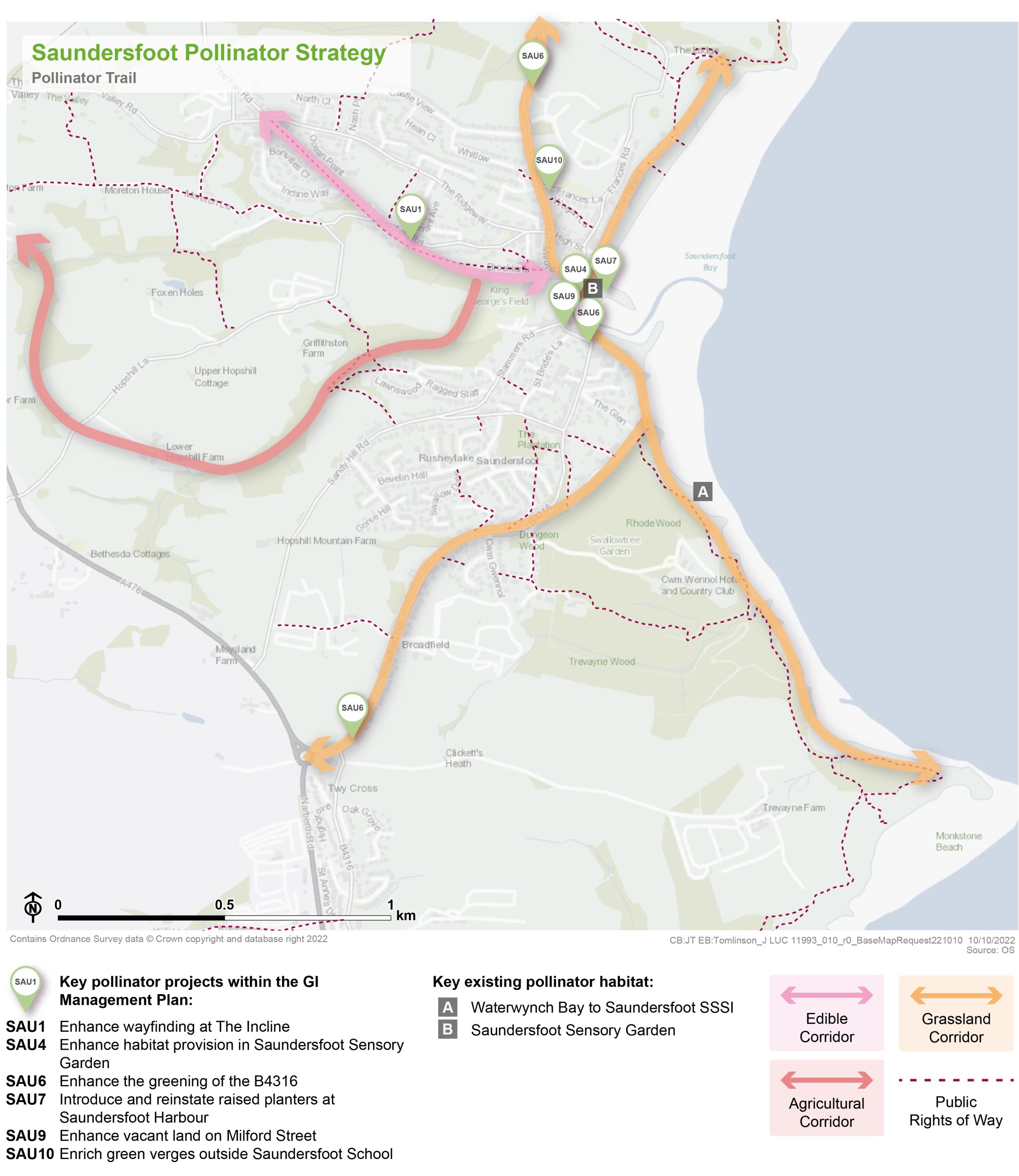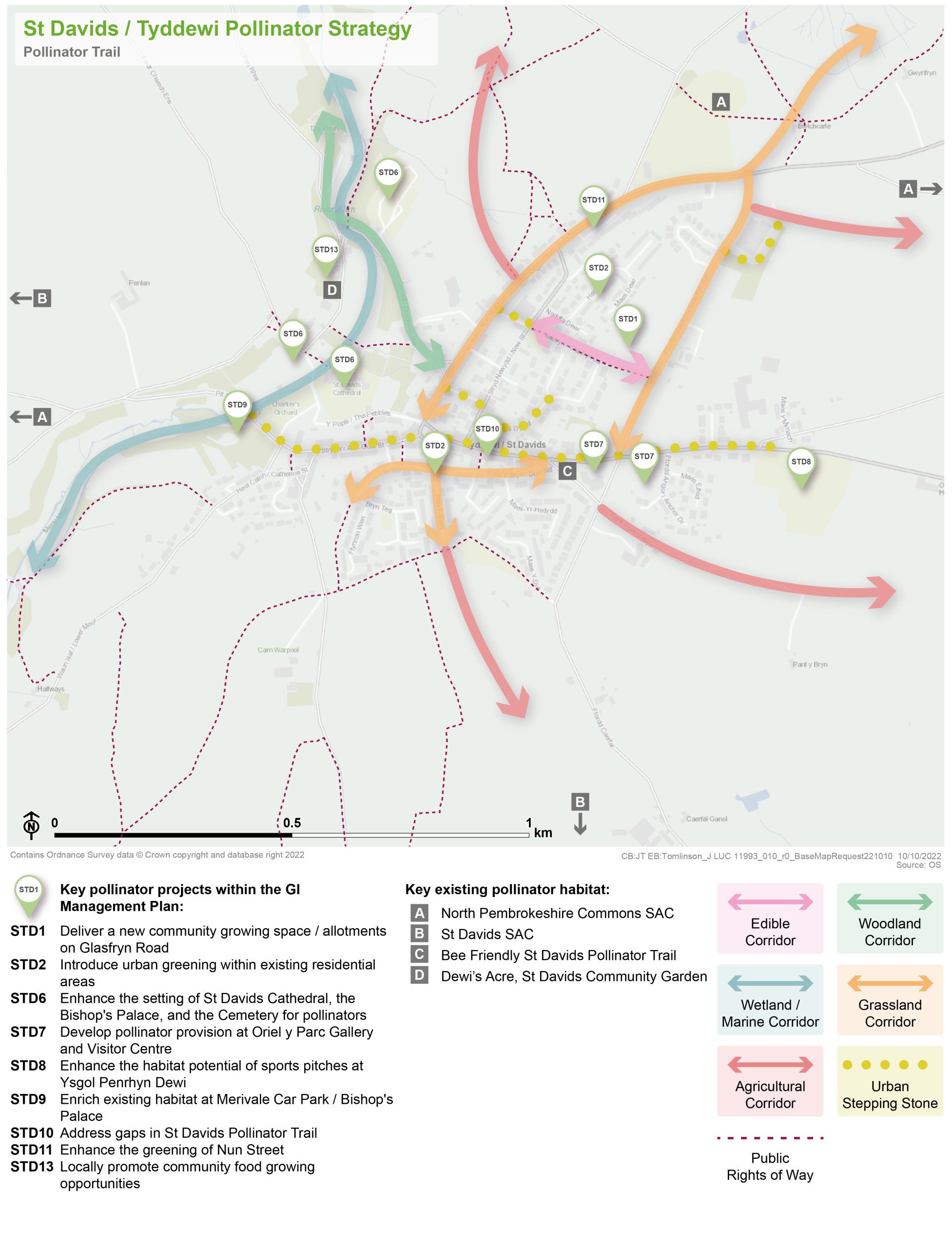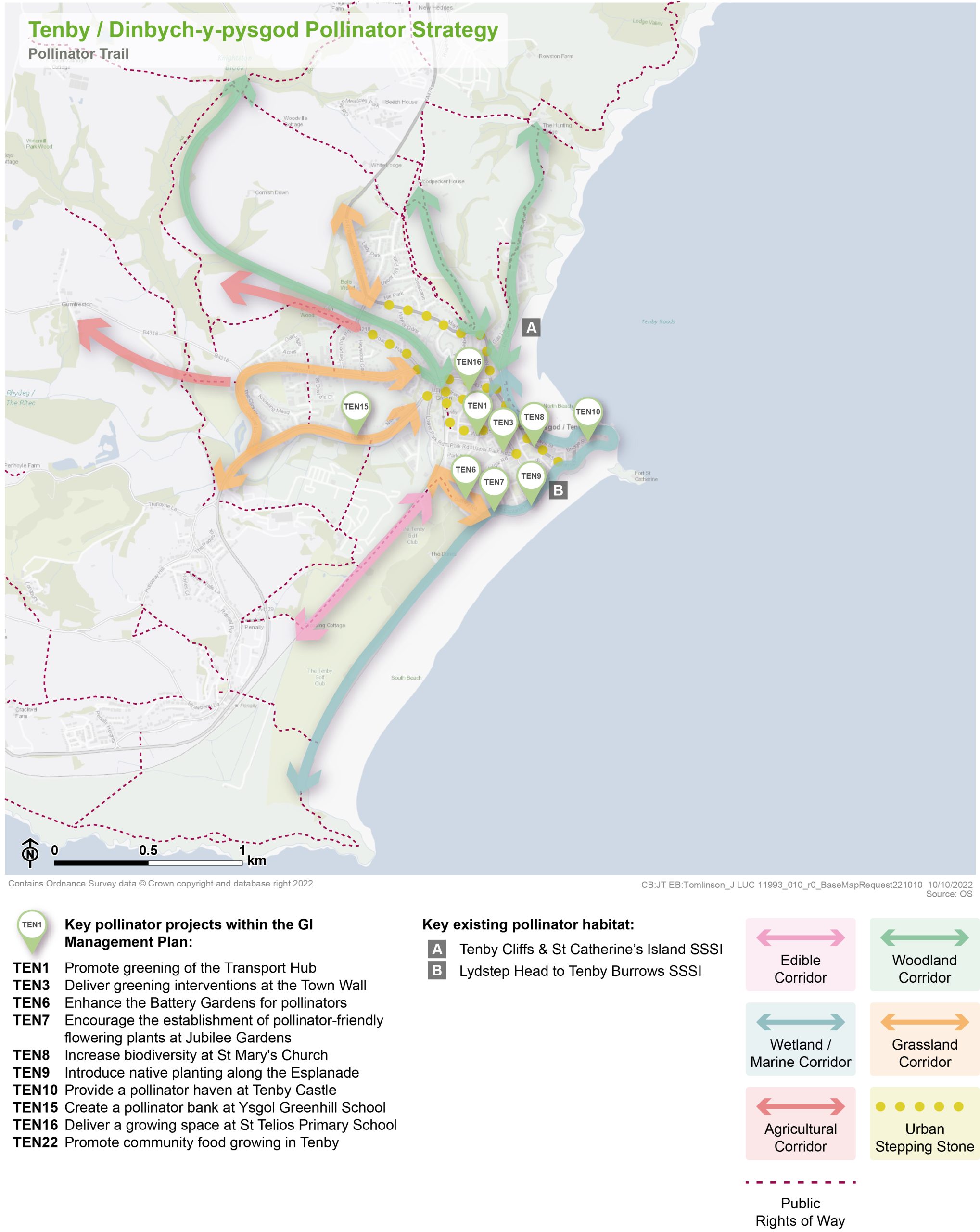Page contents:
Fishguard and Goodwick Pollinator Trail
Haverfordwest Pollinator Trail
Milford Haven Pollinator Trail
Pembroke Dock Pollinator Trail
Strategic pollinator corridors
Pollinator Trails for 11 Settlements
7.1 The pollinator trails build on the overarching pollinator principles by outlining the key priorities for action in each settlement.
Fishgaurd and Goodwick Pollinator Trail
7.2 The Fishguard and Goodwick Pollinator Trail includes:
- Key existing pollinator assets
- Strategic pollinator corridors
- Key projects
7.3 These three aspects are informed by the baseline review, site visits and stakeholder consultation.
7.4 Reflecting Overarching Pollinator Principle 1a ‘Protect and enhance existing pollinator habitat’, the key existing pollinator habitat is also provided for each settlement. While these may not be a focus of a key project, they are nonetheless invaluable as part of the pollinator trail and require safeguarding from damage or disturbance.
7.5 The key existing pollinator habitat includes statutory designations, local green space or where existing pollinator projects or initiatives are taking place. The areas included are not exhaustive and there will be other high-value land for pollinators, for example land in private landownership.
7.6 The different types of strategic pollinator corridors are described in ‘Pollinator Trails for 11 Settlements’.
7.7 The Public Rights of Way Network is shown to encourage exploration of nature between the key pollinator assets and along the strategic corridors.
7.8 More information regarding the scope of each key project can be found in the Fishguard and GI Goodwick Management Plan.
Figure 7.1: Fishguard and Goodwick Pollinator Trail
Haverfordwest Pollinator Trail
7.9 The Haverfordwest Pollinator Trail includes:
- Key existing pollinator assets
- Strategic pollinator corridors
- Key projects
7.10 These three aspects are informed by the baseline review, site visits and stakeholder consultation.
7.11 Reflecting Overarching Pollinator Principle 1a ‘Protect and enhance existing pollinator habitat’, the key existing pollinator habitat is also provided for each settlement. While these may not be a focus of a key project, they are nonetheless invaluable as part of the pollinator trail and require safeguarding from damage or disturbance.
7.12 The key existing pollinator habitat includes statutory designations, local green space or where existing pollinator projects or initiatives are taking place. The areas included are not exhaustive and there will be other high-value land for pollinators, for example land in private landownership.
7.13 The different types of strategic pollinator corridors are described in ‘Pollinator Trails for 11 Settlements’.
7.14 The Public Rights of Way Network is shown to encourage exploration of nature between the key pollinator assets and along the strategic corridors.
7.15 More information regarding the scope of each key project can be found in the Haverfordwest GI Management Plan.
Figure 7.2: Haverfordwest Pollinator Trail
Milford Haven Pollinator Trial
7.16 The Milford Haven Pollinator Trail includes:
- Key existing pollinator assets
- Strategic pollinator corridors
- Key projects
7.17 These three aspects are informed by the baseline review, site visits and stakeholder consultation.
7.18 Reflecting Overarching Pollinator Principle 1c ‘Protect and enhance existing pollinator habitat’, the key existing pollinator habitat is also provided for each settlement. While these may not be a focus of a key project, they are nonetheless invaluable as part of the pollinator trail and require safeguarding from damage or disturbance.
7.19 The key existing pollinator habitat includes statutory designations, local green space or where existing pollinator projects or initiatives are taking place. The areas included are not exhaustive and there will be other high-value land for pollinators, for example land in private landownership.
7.20 The different types of strategic pollinator corridors are described in ‘Pollinator Trails for 11 Settlements’.
7.21 The Public Rights of Way Network is shown to encourage exploration of nature between the key pollinator assets and along the strategic corridors.
7.22 More information regarding the scope of each key project can be found in the Milford Haven GI Management Plan.
Figure 7.3: Milford Haven Pollinator Trail
Narberth Pollinator Trail
7.23 The Narberth Pollinator Trail includes:
- Key existing pollinator assets
- Strategic pollinator corridors
- Key projects
7.24 These three aspects are informed by the baseline review, site visits and stakeholder consultation.
7.25 Reflecting Overarching Pollinator Principle 1a ‘Protect and enhance existing pollinator habitat’, the key existing pollinator habitat is also provided for each settlement. While these may not be a focus of a key project, they are nonetheless invaluable as part of the pollinator trail and require safeguarding from damage or disturbance. The key existing pollinator habitat includes statutory designations, local green space or where existing pollinator projects or initiatives are taking place. The areas included are not exhaustive and there will be other high-value land for pollinators, for example land in private landownership.
7.26 The different types of strategic pollinator corridors are described in ‘Pollinator Trails for 11 Settlements’.
7.27 The Public Rights of Way Network is shown to encourage exploration of nature between the key pollinator assets and along the strategic corridors.
7.28 More information regarding the scope of each key project can be found in the Narberth GI Management Plan.
Figure 7.4: Narberth Pollinator Trail
Newport Pollinator Trail
7.29 The Newport Pollinator Trail includes:
- Key existing pollinator assets
- Strategic pollinator corridors
- Key projects
7.30 These three aspects are informed by the baseline review, site visits and stakeholder consultation.
7.31 Reflecting Overarching Pollinator Principle 1a ‘Protect and enhance existing pollinator habitat’, the key existing pollinator habitat is also provided for each settlement. While these may not be a focus of a key project, they are nonetheless invaluable as part of the pollinator trail and require safeguarding from damage or disturbance.
7.32 The key existing pollinator habitat includes statutory designations, local green space or where existing pollinator projects or initiatives are taking place. The areas included are not exhaustive and there will be other high-value land for pollinators, for example land in private landownership.
7.33 The different types of strategic pollinator corridors are described in ‘Pollinator Trails for 11 Settlements’ .
7.34 The Public Rights of Way Network is shown to encourage exploration of nature between the key pollinator assets and along the strategic corridors.
7.35 More information regarding the scope of each key project can be found in the Newport GI Management Plan.
Figure 7.5: Newport Pollinator Trail
Neyland Pollinator Trail
7.36 The Neyland Pollinator Trail includes:
- Key existing pollinator assets
- Strategic pollinator corridors
- Key projects
7.37 These three aspects are informed by the baseline review, site visits and stakeholder consultation.
7.38 Reflecting Overarching Pollinator Principle 1a ‘Protect and enhance existing pollinator habitat’, the key existing pollinator habitat is also provided for each settlement. While these may not be a focus of a key project, they are nonetheless invaluable as part of the pollinator trail and require safeguarding from damage or disturbance. The key existing pollinator habitat includes statutory designations, local green space or where existing pollinator projects or initiatives are taking place. The areas included are not exhaustive and there will be other high-value land for pollinators, for example land in private landownership.
7.39 The different types of strategic pollinator corridors are described in ‘Pollinator Trails for 11 Settlements’.
7.40 The Public Rights of Way Network is shown to encourage exploration of nature between the key pollinator assets and along the strategic corridors.
7.41 More information regarding the scope of each key project can be found in the Neyland GI Management Plan.
Figure 7.6: Neyland Pollinator Trail
Pembroke Pollinator Trail
7.42 The Pembroke Pollinator Trail includes:
- Key existing pollinator assets
- Strategic pollinator corridors
- Key projects
7.43 These three aspects are informed by the baseline review, site visits and stakeholder consultation.
7.44 Reflecting Overarching Pollinator Principle 1a ‘Protect and enhance existing pollinator habitat’, the key existing pollinator habitat is also provided for each settlement. While these may not be a focus of a key project, they are nonetheless invaluable as part of the pollinator trail and require safeguarding from damage or disturbance.
7.45 The key existing pollinator habitat includes statutory designations, local green space or where existing pollinator projects or initiatives are taking place. The areas included are not exhaustive and there will be other high-value land for pollinators, for example land in private landownership.
7.46 The different types of strategic pollinator corridors are described in ‘Pollinator Trails for 11 Settlements’.
7.47 The Public Rights of Way Network is shown to encourage exploration of nature between the key pollinator assets and along the strategic corridors.
7.48 More information regarding the scope of each key project can be found in the Pembroke GI Management Plan.
Figure 7.7: Pembroke Pollinator Trail
Pembroke Dock Pollinator Trail
7.49 The Pembroke Dock Pollinator Trail includes:
- Key existing pollinator assets
- Strategic pollinator corridors
- Key projects
7.50 These three aspects are informed by the baseline review, site visits and stakeholder consultation.
7.51 Reflecting Overarching Pollinator Principle 1a ‘Protect and enhance existing pollinator habitat’, the key existing pollinator habitat is also provided for each settlement. While these may not be a focus of a key project, they are nonetheless invaluable as part of the pollinator trail and require safeguarding from damage or disturbance. The key existing pollinator habitat includes statutory designations, local green space or where existing pollinator projects or initiatives are taking place. The areas included are not exhaustive and there will be other high-value land for pollinators, for example land in private landownership.
7.52 The different types of strategic pollinator corridors are described in ‘Pollinator Trails for 11 Settlements’.
7.53 The Public Rights of Way Network is shown to encourage exploration of nature between the key pollinator assets and along the strategic corridors.
7.54 More information regarding the scope of each key project can be found in the Pembroke Dock GI Management Plan.
Figure 7.8: Pembroke Dock Pollinator Trail
Saundersfoot Pollinator Trail
7.55 The Saundersfoot Pollinator Trail includes:
- Key existing pollinator assets
- Strategic pollinator corridors
- Key projects
7.56 These three aspects are informed by the baseline review, site visits and stakeholder consultation.
7.57 Reflecting Overarching Pollinator Principle ‘Protect and enhance existing pollinator habitat’, the key existing pollinator habitat is also provided for each settlement. While these may not be a focus of a key project, they are nonetheless invaluable as part of the pollinator trail and require safeguarding from damage or disturbance.
7.58 The key existing pollinator habitat includes statutory designations, local green space or where existing pollinator projects or initiatives are taking place. The areas included are not exhaustive and there will be other high-value land for pollinators, for example land in private landownership.
7.59 The different types of strategic pollinator corridors are described in ‘Pollinator Trails for 11 Settlements’.
7.60 The Public Rights of Way Network is shown to encourage exploration of nature between the key pollinator assets and along the strategic corridors.
7.61 More information regarding the scope of each key project can be found in the Saundersfoot GI Management Plan.
Figure 7.9: Saundersfoot Pollinator Trail
St Davids Pollinator Trail
7.62 The St Davids Pollinator Trail includes:
- Key existing pollinator assets
- Strategic pollinator corridors
- Key projects
7.63 These three aspects are informed by the baseline review, site visits and stakeholder consultation.
7.64 Reflecting Overarching Pollinator Principle 1a ‘Protect and enhance existing pollinator habitat’, the key existing pollinator habitat is also provided for each settlement. While these may not be a focus of a key project, they are nonetheless invaluable as part of the pollinator trail and require safeguarding from damage or disturbance.
7.65 The key existing pollinator habitat includes statutory designations, local green space or where existing pollinator projects or initiatives are taking place. The areas included are not exhaustive and there will be other high-value land for pollinators, for example land in private landownership.
7.66 The different types of strategic pollinator corridors are described in ‘Pollinator Trails for 11 Settlements.
7.67 The Public Rights of Way Network is shown to encourage exploration of nature between the key pollinator assets and along the strategic corridors.
7.68 More information regarding the scope of each key project can be found in the St Davids GI Management Plan.
Figure 7.10: St Davids Pollinator Trail
Tenby Pollinator Trail
7.69 The Tenby Pollinator Trail includes:
- Key existing pollinator assets
- Strategic pollinator corridors
- Key projects
7.70 These three aspects are informed by the baseline review, site visits and stakeholder consultation.
7.71 Reflecting Overarching Pollinator Principle 1a ‘Protect and enhance existing pollinator habitat’, the key existing pollinator habitat is also provided for each settlement. While these may not be a focus of a key project, they are nonetheless invaluable as part of the pollinator trail and require safeguarding from damage or disturbance.
7.72 The key existing pollinator habitat includes statutory designations, local green space or where existing pollinator projects or initiatives are taking place. The areas included are not exhaustive and there will be other high-value land for pollinators, for example land in private landownership.
7.73 The different types of strategic pollinator corridors are described in ‘Pollinator Trails for 11 Settlements’.
7.74 The Public Rights of Way Network is shown to encourage exploration of nature between the key pollinator assets and along the strategic corridors.
7.75 More information regarding the scope of each key project can be found in the Tenby GI Management Plan.
Figure 7.11: Tenby Pollinator Trail
Strategic pollinator corridors
7.76 For each of the 11 settlements, strategic pollinator corridors have been identified. These corridors are a key component of wider ecological networks, connecting core pollinator areas and stepping stone habitats. They enable species to move, disperse, migrate and reproduce and become more resilient to threats such as climate change and loss of habitat.
7.77 These corridors also reflect focus opportunity areas for improving connectivity for pollinators, for example a wide continuous grass verge that is currently closely mown but has potential for enhancement. These have been identified using pollinator habitat suitability modelling and B-Lines data sets, as well as site visits and aerial imagery.
7.78 Generic actions to strengthen the function and continuity of these corridors are outlined below.
7.79 Areas outside of the strategic corridors may still have potential importance for pollinators and should still be considered as part of proposals for creating, enhancing and connecting pollinator habitat.
Woodland corridors
7.80 Floral resources for pollinators are often in short supply early in the year before the main flowering period of herbaceous plants in road verges, field margins and meadows. At this time of year, flowering shrubs and trees in woods, as well as woodland ground flora such as bluebells, wood anemones, violets can provide valuable sources of nectar and pollen.
7.81 Creating a few metres of uncultivated or unmown habitat along woodland edges where hogweed, cow parsley, thistles, knapweeds ragwort and some bramble can grow will benefit pollinators. Rides and clearings can extend this open habitat supporting the warm and sunny conditions that pollinators prefer. Creation of coppiced areas, dead wood, exposed root plates, varied topography and wet woodland can also provide habitat for pollinators at various stages of their life cycle.
Edible corridors
7.82 Community gardens and edible corridors can provide excellent pollinator habitat but also serve the local community for foraging opportunities and recreational usage. It can reduce the impact of food poverty in low-income areas and allow residents greater access to nutritious food.
7.83 Planting of fruit trees, flowering vegetables and herbs, replacing ornamental hedgerows or filling gaps in hedgerows with native species that fruit berries or nuts will provide for people and pollinators. National Botanic Garden of Wales has produced the top 50 edible plants for pollinators (Opens in new window). This provides a selection of fruit trees, to grow for food whilst attracting pollinators. Species which could be planted include apple, pear, bramble, elder, plum and hazelnut.
Wetland or marine corridors
7.84 Wet features such as canals and balancing pools with marginal swamp, along with ditches support wetland flowers such as Marsh marigold, Marsh woundwort, Meadowsweet and Great willowherb, all of which are good sources of pollen and nectar.
7.85 Many hoverflies require ‘hoverfly lagoons’ for their aquatic larval life stage. Ponds or wet habitat can support the larvae of pollinators such as drone flies and can also provide flowering features if the right plants are used e.g. water mint, purple loosestrife, angelica and marsh woundwort which benefit other pollinators too.
7.86 Marine corridors are most commonly those atop cliff faces or on the seashore where plants will be more highly exposed to salt spray in the air and salt accumulation in the soil. Salt tolerant native plants should be planted to ensure successful establishment. As many of the settlements are coastal salt tolerance will also be a factor to consider for some identified grassland corridors.
Grassland corridors
7.87 Wildflower-rich grasslands are essential for many pollinating insects. Grasslands on less fertile soils can be incredibly flower-rich, with species such as bird’s-foot trefoils, Cowslip, Oxeye daisy, bedstraws and orchids.
7.88 One of the easiest way to promote a pollination corridor is by changing mowing regimes. Road verges, embankments, slopes and perimeters or corners of open spaces can all be cut less frequently to allow plants to flower. Cutting regimes should aim to find a balance between safety, amenity and the needs of pollinators/wildlife.
7.89 Marshy grasslands, such as the Molinia meadows found at North West Pembrokeshire Commons SAC are also extremely valuable to pollinators. Maintaining appropriate grazing regime will be required to achieve a species-rich sward community that supports a diverse number of pollinator.
Agricultural corridors
7.90 The edges of arable fields are ideal locations for increasing pollinator habitat and connectivity into the wider countryside. They are often less fertile, less productive or inaccessible to modern farm machinery, and so considered less valuable for crop production. Establishing a mix of legumes and native wildflowers in plots or strips in or around arable fields can provide pollinating insects with good sources of pollen and nectar from March through to October.
7.91 The margins will work best in combination with sensitive hedgerow management to provide early sources of pollen and nectar from flowering hawthorn and blackthorn. Hedges provide flowers, shelter from wind, food plants for pollinator larvae and overwintering sites in the hedge bottoms.
7.92 Most agricultural land will have potential for restoration or enhancement of pollinator habitat features. This will often require engagement with private landowners. These corridors are intended to indicate general permeability into the agricultural matrix rather than a specifically spatially defined corridor.
Habitat mosaic corridors
7.93 In some cases, natural corridors through the landscape e.g. river corridors, will take in many different types of habitats, such as mosaics of wetland, wet grassland, species-rich grassland, tall-herb communities, scrub, heathland and scattered pockets of woodland. A variety of features supporting pollinators can be enhanced and created, such as dead wood, bare earth, habitat piles, varied grass swards, leaf litter, open bracken and scrub.
Urban stepping stones
7.94 Where space is limited, adding more diverse planters, flowerbeds and hanging baskets to the public realm and housing estates can provide good sources of pollen and nectar from spring to autumn, safe places to breed and overwinter and safe flyways. Walls and bridges can support native flowering climbers such as Ivy and Honeysuckle. Old brickwork and stonework also has its own flowery habitat with Oxford ragwort, Red valerian, Ivy-leaved toadflax and Elder.
7.95 They can also provide a range of other benefits, including improving air quality by filtering pollutants and improving mental and physical health by bringing people closer to nature through creating inviting green spaces. It can also increase economic benefits as the addition of plants, flowers and shrubs help cultivate a positive environment attracting more customers to towns and potentially increase property values.
Back to top
Previous Chapter:
Overarching Pollinator Principles
Next Chapter:
Delivery – Pollinator Strategies
Return to homepage:
Homepage
